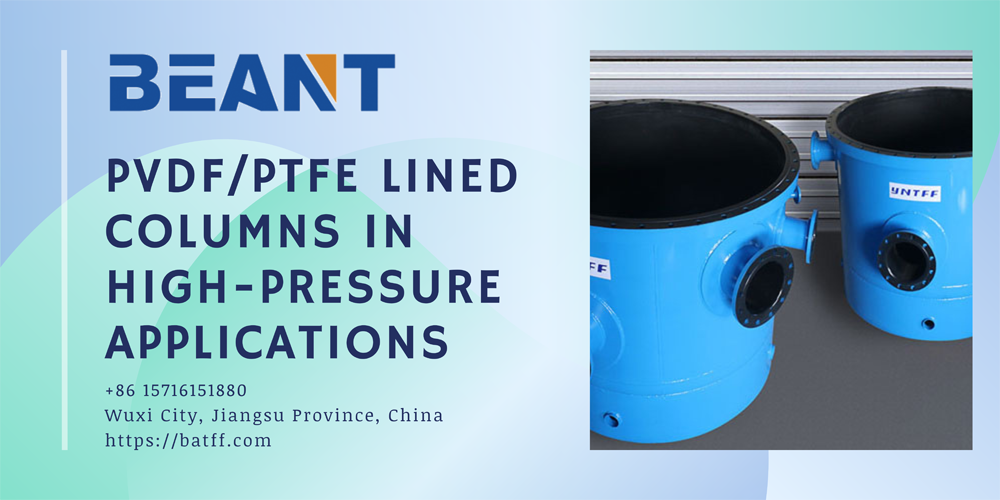
Polyvinylidene Fluoride (PVDF) and Polytetrafluoroethylene (PTFE) are two of the most robust materials used in the lining of columns for chemical processing. PVDF is known for its high purity, superior chemical resistance, and excellent mechanical properties, making it suitable for handling a wide range of chemicals at varying temperatures. PTFE, often recognized under the brand name Teflon®, offers unmatched thermal stability and resistance to corrosive substances, even at high temperatures and pressures. These linings ensure that the columns can withstand aggressive chemicals without degrading or contaminating the process streams.
Why are these linings so crucial in high-pressure chemical processes? In environments where chemicals are processed under high pressure, the integrity of the column’s structure and the purity of the chemical products are paramount. High-pressure processes can accelerate the degradation of materials and lead to failures, contaminations, and costly downtime. PVDF and PTFE linings provide the necessary resilience against such conditions, enabling safe and efficient operations.
The objective of this article is to explore the role of PVDF and PTFE Lined Columns in high-pressure applications. We aim to understand how these linings contribute to the performance and safety of chemical processing plants and to identify the challenges and future trends that could shape their use. By delving into this topic, we seek to provide valuable insights for engineers, chemists, and industry professionals looking to optimize their high-pressure processes.
What makes PVDF and PTFE exceptional choices for linings in demanding environments? Thermal stability and chemical resistance are among the most critical attributes.
Thermal Stability: PVDF operates efficiently within a temperature range of -30°C to 150°C, making it a versatile choice for varying thermal conditions. PTFE, on the other hand, has an even broader temperature tolerance, ranging from -200°C to 260°C. This remarkable stability under thermal stress ensures that both materials can withstand sudden temperature changes and high heat environments without deforming or losing integrity.
Chemical Resistance: Both materials exhibit superior resistance to a wide array of chemicals. PVDF is particularly resistant to halogens and strong acids and bases, which are common in many industrial processes. PTFE is almost universally chemically inert, resisting corrosive substances like aqua regia and sulfuric acid, which makes it invaluable in processes involving highly corrosive chemicals.
Why are PVDF and PTFE linings so beneficial in high-pressure environments? The key lies in their corrosion resistance and mechanical strength.
Corrosion Resistance: In high-pressure conditions, the potential for corrosion increases due to the intensified contact between the column material and aggressive substances. PVDF and PTFE linings serve as a protective barrier, preventing the underlying column material from corrosive attack and thereby prolonging the equipment’s life.
Mechanical Strength and Durability: Under high pressures, the structural integrity of the column is paramount. PVDF offers excellent mechanical strength and creep resistance, which are crucial in maintaining the shape and functionality of the column under continuous stress. PTFE, while softer, compensates with its flexibility and ability to conform to surface irregularities, ensuring a tight seal and resistance to leaks.
Where do we typically see these lined columns in action? Petrochemicals, pharmaceuticals, and food processing industries provide clear examples.
Petrochemicals: High-pressure reactors and distillation columns in the petrochemical industry often use PVDF linings to handle hot, corrosive fluids like hydrocarbons and acids over extended periods without degradation.
Pharmaceuticals: In pharmaceutical production, maintaining product purity is essential. PTFE-lined columns are used to ensure that active pharmaceutical ingredients are processed without contamination from the equipment, particularly in high-pressure chromatography.
Food Processing: PVDF and PTFE linings are used in food processing to prevent contamination and withstand the rigorous cleaning processes necessary to meet food safety standards. Their inert nature ensures that no harmful substances leach into the food product.
What challenges do engineers face when designing columns for high-pressure operations? The material selection and structural integrity are critical factors.
Material Selection Based on Pressure Ratings: Choosing the right material for lined columns is crucial, particularly in high-pressure environments. PVDF and PTFE are selected based on their ability to withstand specific pressure ranges without deforming. PVDF is often preferred for its higher structural strength in moderate pressure ranges, while PTFE is favored in extremely high temperatures and pressures due to its superior flexibility and chemical inertness.
Structural Integrity Under Pressure: The design must ensure that the column maintains its integrity under the operational pressures. This involves calculating the stress distribution and optimizing the column thickness and structure to prevent buckling or rupture. Finite element analysis (FEA) is frequently used to simulate stress and strain on the columns to predict and mitigate potential failure points.
How are PVDF/PTFE lined columns manufactured to meet high standards? Techniques for lining and quality assurance are essential steps.
Techniques for Lining Columns with PVDF/PTFE: The lining process involves careful application of PVDF or PTFE to the inner surfaces of the column. This can be done through sheet lining, where pre-formed sheets of lining material are welded and applied, or by using a rotational lining process, where liquid resin is hardened inside the rotating column to form a uniform layer.
Quality Assurance in Manufacturing: Ensuring the quality of lined columns involves rigorous testing of the linings for defects such as pinholes, cracks, or weak seams. Ultrasonic testing and high-voltage spark testing are common methods used to detect any imperfections that could compromise the column’s performance in high-pressure environments.
What are the maintenance and durability concerns in high-pressure applications? Wear and tear and maintenance strategies play significant roles.
Wear and Tear Issues: Over time, high-pressure operations can cause wear and tear on PVDF and PTFE linings, leading to thinning or the development of weak spots. This wear can be accelerated by abrasive substances or rapid pressure fluctuations, leading to potential failures.
Maintenance Strategies for Longevity: Regular inspections and maintenance are crucial for extending the life of lined columns. This includes scheduled downtime for the inspection of linings and the use of non-destructive testing techniques to identify and repair early signs of wear before they lead to significant damage.
What operational challenges arise from temperature and pressure fluctuations? Operational stability and compliance are key concerns.
Temperature and Pressure Fluctuations: Fluctuations in temperature and pressure can strain the linings, causing expansion, contraction, and even delamination. Engineers must design the columns to accommodate these changes without compromising the lining’s integrity.
Safety and Regulatory Considerations: Adhering to safety standards and regulatory requirements is essential in high-pressure operations. This includes following guidelines for pressure vessel design, ensuring all materials meet the necessary certifications, and implementing safety protocols to protect workers and the environment.
What new materials and technologies are competing with PVDF/PTFE? Innovation in materials is transforming the industry.
New Materials Competing with PVDF/PTFE: Researchers are developing new polymers and composite materials that offer similar or improved properties compared to PVDF and PTFE. These include advanced ceramics and nano-coated materials that provide enhanced durability and chemical resistance.
Technological Advancements in Column Lining: The use of additive manufacturing (3D printing) and smart materials that adapt to environmental changes are among the latest innovations. These technologies promise more precise and efficient manufacturing of lined columns with improved performance characteristics.
Throughout this article, we've explored the robust characteristics and numerous applications of PVDF and PTFE lined columns, particularly in high-pressure environments. These linings are essential for ensuring thermal stability, chemical resistance, and mechanical integrity under challenging operational conditions.
What role will these materials play in the future of high-pressure applications? PVDF and PTFE lined columns are set to become even more critical as industries push towards more efficient, safe, and environmentally friendly processes. Their ability to withstand harsh conditions while maintaining purity and integrity makes them indispensable in the evolving landscape of chemical processing.
In conclusion, for those looking to enhance the performance and longevity of their high-pressure systems, the continued use and development of PVDF and PTFE linings come highly recommended. Investing in quality design, regular maintenance, and staying abreast of material innovations will ensure optimal operation and compliance with future standards.
Feel free to leave your message on our board. If you're looking to inquire about prices or place an order, this is the right place! Let us know the details of your needs, and our team will get back to you with a personalized quote as quickly as possible. We're here to ensure your experience is seamless and satisfactory. Share your requirements or ask any questions you might have - we're eager to assist and look forward to doing business with you!
Name:Tim
Phone:+86-15716151880
Email:[email protected]
Company:BEANT
Address:No. 28, Luoshen Road, Luoshe Town, Huishan District, Wuxi City, Jiangsu Province
